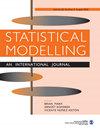Penalty parameter selection and asymmetry corrections to Laplace approximations in Bayesian P-splines models
IF 1.2
4区 数学
Q2 STATISTICS & PROBABILITY
引用次数: 0
Abstract
Laplace P-splines (LPS) combine the P-splines smoother and the Laplace approximation in a unifying framework for fast and flexible inference under the Bayesian paradigm. The Gaussian Markov random field prior assumed for penalized parameters and the Bernstein-von Mises theorem typically ensure a razor-sharp accuracy of the Laplace approximation to the posterior distribution of these quantities. This accuracy can be seriously compromised for some unpenalized parameters, especially when the information synthesized by the prior and the likelihood is sparse. Therefore, we propose a refined version of the LPS methodology by splitting the parameter space in two subsets. The first set involves parameters for which the joint posterior distribution is approached from a non-Gaussian perspective with an approximation scheme tailored to capture asymmetric patterns, while the posterior distribution for the penalized parameters in the complementary set undergoes the LPS treatment with Laplace approximations. As such, the dichotomization of the parameter space provides the necessary structure for a separate treatment of model parameters, yielding improved estimation accuracy as compared to a setting where posterior quantities are uniformly handled with Laplace. In addition, the proposed enriched version of LPS remains entirely sampling-free, so that it operates at a computing speed that is far from reach to any existing Markov chain Monte Carlo approach. The methodology is illustrated on the additive proportional odds model with an application on ordinal survey data.贝叶斯p样条模型拉普拉斯近似的惩罚参数选择和不对称校正
拉普拉斯p样条(LPS)将p样条光滑和拉普拉斯近似结合在一个统一的框架中,在贝叶斯范式下实现快速灵活的推理。高斯马尔可夫随机场预先假定惩罚参数和伯恩斯坦-冯米塞斯定理通常确保了这些量的后验分布的拉普拉斯近似的精确程度。对于一些未惩罚参数,特别是当先验和似然合成的信息是稀疏的时,这种准确性可能会受到严重损害。因此,我们提出了一种改进版的LPS方法,将参数空间分成两个子集。第一组参数的联合后验分布从非高斯的角度用一种专为捕获不对称模式而定制的近似方案来处理,而互补组中惩罚参数的后验分布则用拉普拉斯近似进行LPS处理。因此,参数空间的二分类为模型参数的单独处理提供了必要的结构,与用拉普拉斯统一处理后验量的设置相比,可以提高估计精度。此外,所提出的强化版LPS仍然完全不需要采样,因此它的计算速度远远达不到任何现有的马尔可夫链蒙特卡洛方法。通过对顺序调查数据的应用,说明了加性比例赔率模型的方法。
本文章由计算机程序翻译,如有差异,请以英文原文为准。
求助全文
约1分钟内获得全文
求助全文
来源期刊

Statistical Modelling
数学-统计学与概率论
CiteScore
2.20
自引率
0.00%
发文量
16
审稿时长
>12 weeks
期刊介绍:
The primary aim of the journal is to publish original and high-quality articles that recognize statistical modelling as the general framework for the application of statistical ideas. Submissions must reflect important developments, extensions, and applications in statistical modelling. The journal also encourages submissions that describe scientifically interesting, complex or novel statistical modelling aspects from a wide diversity of disciplines, and submissions that embrace the diversity of applied statistical modelling.
 求助内容:
求助内容: 应助结果提醒方式:
应助结果提醒方式:


